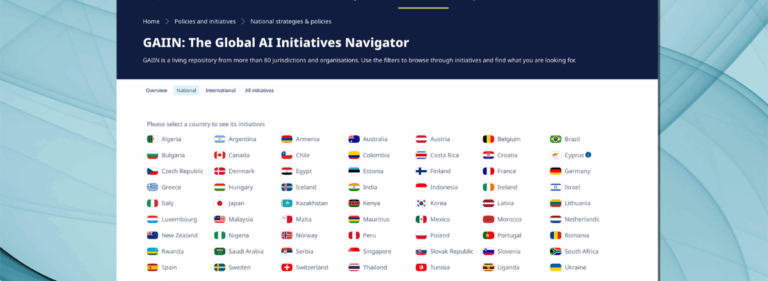Data from tech and social platforms underline the success of India’s AI upskilling policies

With its well-established IT sector and knowledge base, India possesses many necessary resources to become an AI superpower. The government is capitalising on this strong foundation by leveraging AI to solve public problems through its national AI strategy released in 2018. The strategy, coined AI for Al, also focuses on upskilling and reskilling to foster inclusive growth.
OECD.AI’s Trends and Data platform uses external data sources to quantify and track the growth of AI skills in countries over time. Since the release of India’s AI strategy in 2018, several of India’s indicators have grown remarkably. This growth suggests that its national strategy has helped people to acquire AI skills. To illustrate this, we highlight trends from three data sources available on OECD.AI: GitHub (software development), Stack Overflow (programming forum) and LinkedIn (AI talent concentration).
Questions and answers on Stack Overflow point to upskilling
Programming forums such as Stack overflow are essential resources for AI developers to discuss and resolve programming challenges. AI developers use the platform to ask and answer questions from the AI community. OECD.AI’s live data tool can compare international ‘AI knowledge flows’ over time by leveraging aggregate data from user activity.
While growing activity on Stack Overflow can provide an indicator for developing AI skills, analysing data for questions and answers provides insight into the type of activity. As experienced programmers are more likely to answer questions than inexperienced users, a user’s activity should correspond to his or her skill level: beginners are more likely to use the forum to post questions rather than answers. Data aggregated to the country level can give insights into levels of AI programming skills.
While growing activity on Stack Overflow can provide an indicator for developing AI skills, filtering data by questions and answers provides insight into the type of activity. As experienced programmers are more likely to answer questions than inexperienced users, a user’s activity should correspond to his or her skill level: beginners are more likely to use the forum to post questions rather than answers. Data aggregated at the country level can give insights into levels of AI programming skills.
Evolution of AI questions on Stack Overflow by country
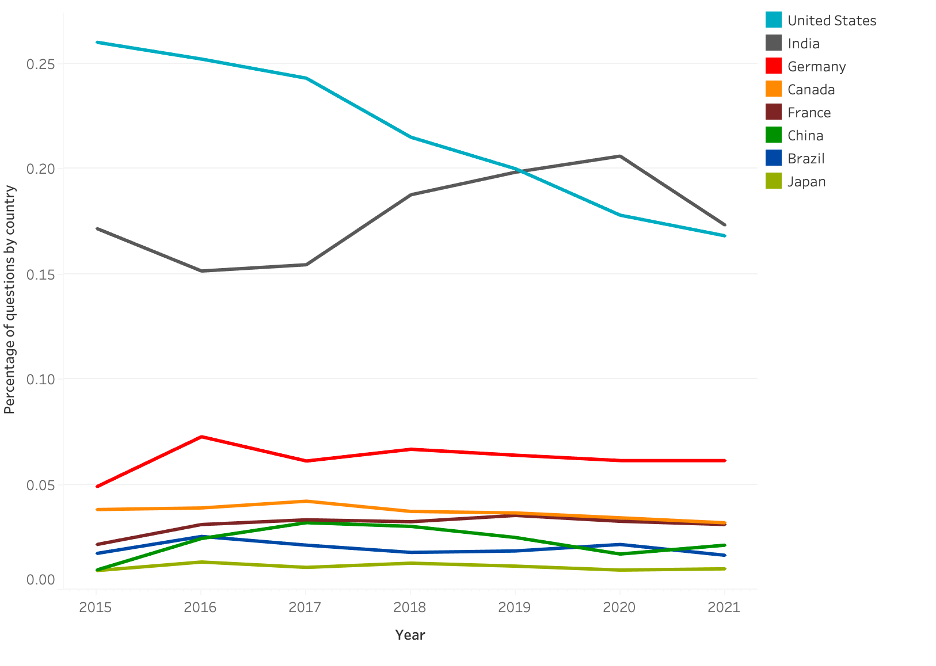
Source: OECD.AI.
Evolution of AI answers on Stack Overflow by country
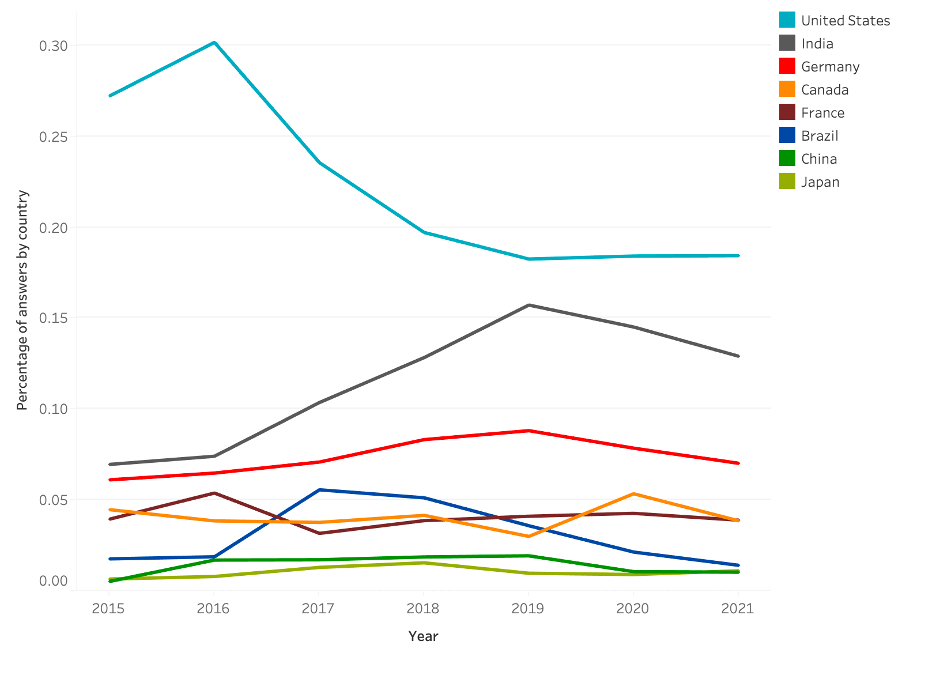
Source: OECD.AI
From 2018 to 2020, the number of questions from India on Stack overflow increased dramatically as a percentage of the total, overtaking the United States as the most active country on the platform in terms of questions. India’s question activity peaked in 2020 at 21% of total questions before decreasing slightly in 2021. Following our logic, this trend is likely related to the increase in people interested in gaining AI skills through online platforms at the beginning of the COVID-19 crisis.
India’s answer activity rapidly increased from 2015 to 2019 and still maintains a strong position. However, it remains lower than its question activity each year, indicating that its users are more likely to use the site to gain knowledge than provide solutions. India’s per cent of total activity stabilized over the past two years and is expected to maintain that position or grow as the population gains AI expertise.
Tracking AI software development in India with GitHub
GitHub is a popular collaborative tool where AI developers and data scientists write and store code. OECD.AI tracks the number of contributions, called ‘commits’, that developers make to AI projects on the platform. Data from tracking the geographic distribution of developers committing to projects can reveal who is developing AI software, where, and how fast.
GitHub contributions by country
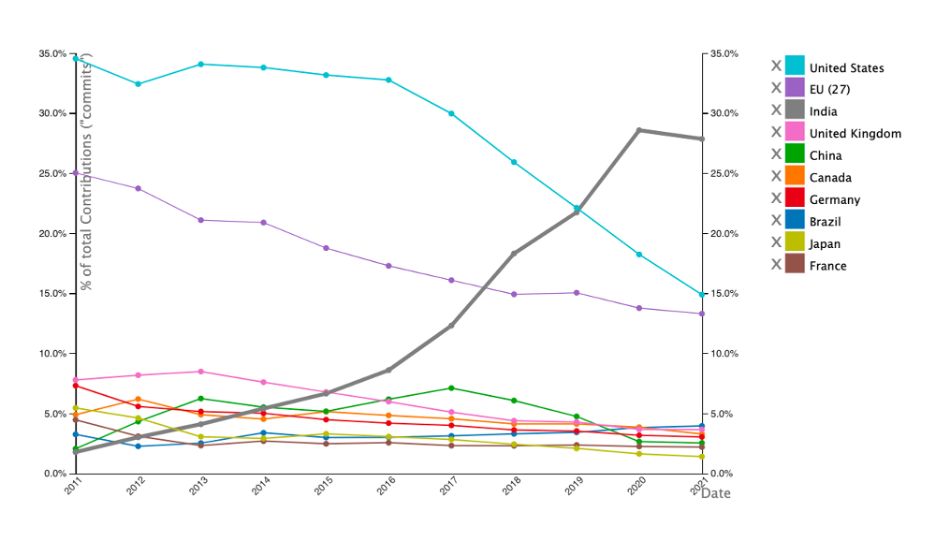
Source: OECD.AI
India’s activity on GitHub has increased over many years, with growth accelerating rapidly in 2017. Like Stack Overflow trends, India’s GitHub activity peaked in 2020, with over 25% of all contributions coming from India. It took the #1 position for commits to public AI software development, more than the United States. While India’s growth in this area slowed in 2021, it maintains a strong position as the most represented country on the website.
Data from LinkedIn shows AI talent concentration
By leveraging social media data, OECD.AI provides insights into AI talent concentration on LinkedIn. ‘Talent concentration’ is the percentage of LinkedIn users with AI skills or performing an AI occupation in each country annually. As this metric is dependent on LinkedIn coverage in a particular country, we focus on the overall trend of AI talent concentration in each country and its year-over-year growth.
AI talent concentration on LinkedIn by country
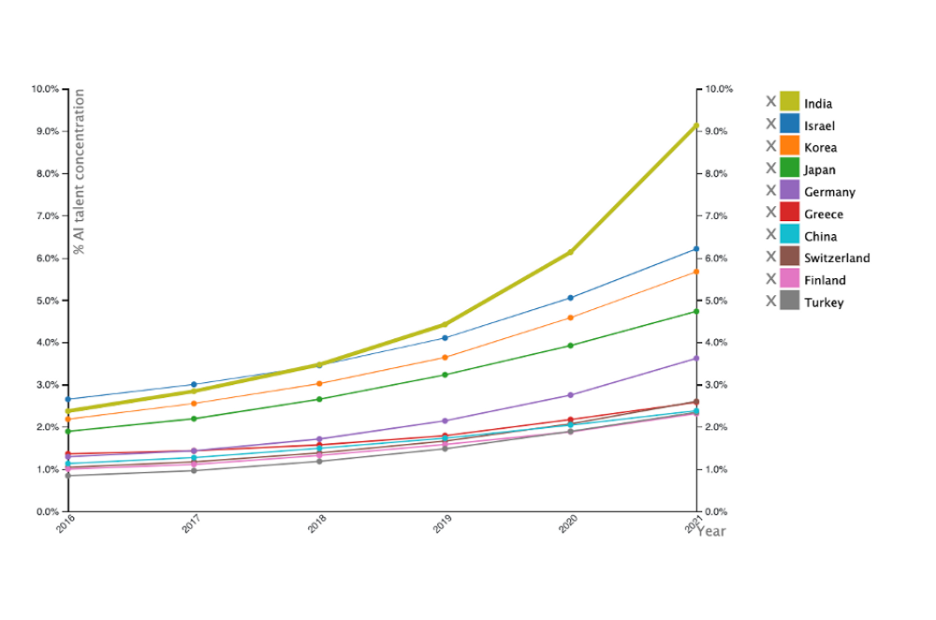
Source: OECD.AI
In 2020 and 2021, India saw a sharp increase in the proportion of ‘AI talent’ on LinkedIn. This increased trend could be attributed to people ‘reskilling’ or leveraging AI skills to begin new projects and roles in their industry. Through OECD.AI’s AI talent concentration by country and industry, we can see that more AI skills in the Software and IT services sector account for much of the increase, although all sectors, including education, finance, hardware & networking, and manufacturing, show a sharp increase beginning in 2019.
The talent concentration in India is increasing faster than in any other country. Our evidence attributes this to India’s upskilling efforts across the general public and increased AI-related jobs across various sectors. This growth reflects India’s commitment to creating opportunities for AI professionals across various sectors.
How and why India is upskilling
To facilitate upskilling, the Indian government integrates AI into their education policies by providing courses to reskill professionals and promoting gender equality in AI professions. People in India use popular platforms such as NPTEL’s SWAYAM, upGrad, Udemy and Coursera to learn AI skills. These courses and online certificates offered by Indian universities have become popular since the COVID-19 pandemic.
The prevalence of online learning and the shift towards remote working have incentivised a larger portion of the public to adopt AI skills. While high paying IT jobs were traditionally located in cities such as Bangalore, Chennai, and Hyderabad, many of these roles are now accessible to a larger portion of the population thanks to remote work.
Data sources on OECD.AI show that India’s AI capabilities have increased dramatically since 2018, meaning it could soon become a leader in AI talent. This means AI has the potential to shape India’s economic future. As this unfolds, tracking data related to India’s AI capabilities will show how quickly it moves towards the goals defined in its policies.
Learn more about India’s AI strategy, policies and data on its country page on OECD.AI.
This article was made in collaboration with the ACSS Institute and greatly benefited from Jibu Elias’ (INDIAai) knowledge and advice.



































